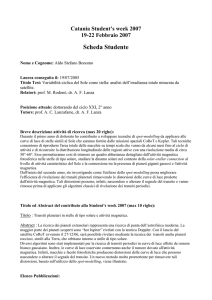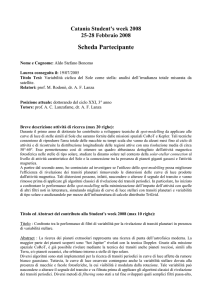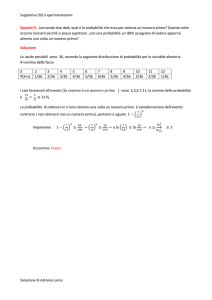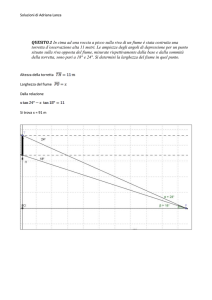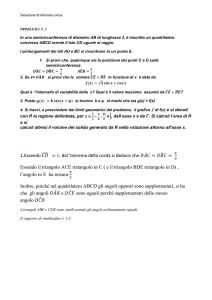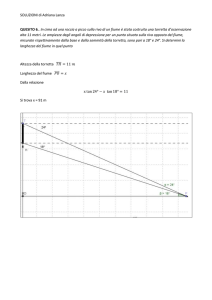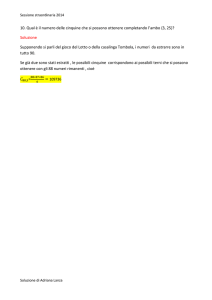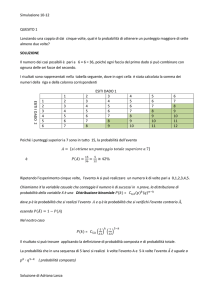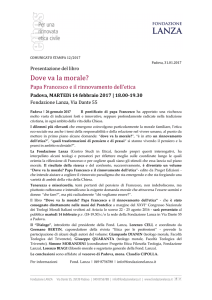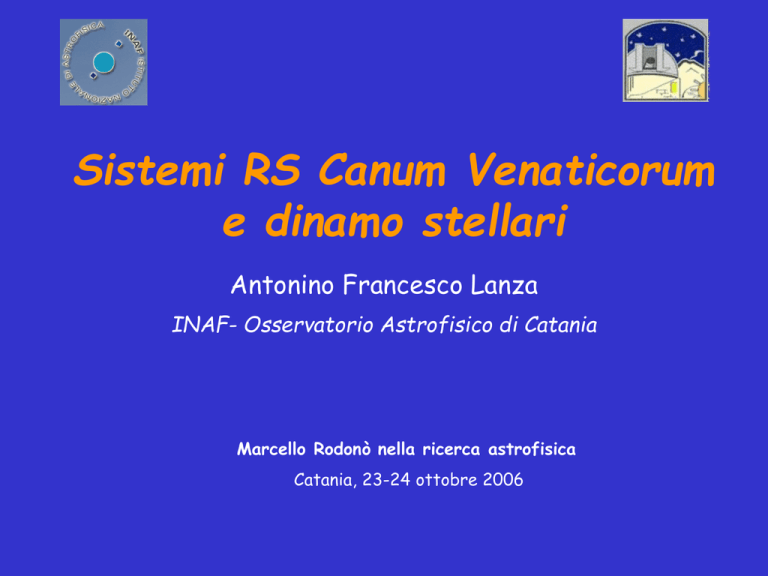
Sistemi RS Canum Venaticorum
e dinamo stellari
Antonino Francesco Lanza
INAF- Osservatorio Astrofisico di Catania
Marcello Rodonò nella ricerca astrofisica
Catania, 23-24 ottobre 2006
Sistemi binari RS CVn
• Sono sistemi binari stretti, distaccati, formati da una primaria di
tipo spettrale FV o GV e da una secondaria di tipo GIV o KIV;
• il rapporto delle masse è prossimo all’unità con la subgigante
secondaria generalmente del 10-20% più massiccia della primaria;
• la secondaria mostra un’intensa attività cromosferica e coronale di
origine magnetica;
• la sua fotosfera è caratterizzata da disomogeneità di brillanza
(macchie), più fredde della fotosfera imperturbata, che producono
una caratteristica modulazione della curva di luce ottica mentre la
stella ruota.
Esempio: Il sistema binario stretto V711 Tauri (HR 1099)
La componente KIV è circa 4 volte più luminosa della G5V e domina le
variazioni fotometriche del sistema
Curve di luce di V711 Tauri
(Rodonò et al. 1986, A&A 165, 135)
Eclissi e modulazione rotazionale della
curva di luce: il prototipo RS CVn
Rodonò, Lanza, Catalano, A&A 301, 75 (1995)
Rilevanza dello studio dei sistemi RS CVn
• Variabilità nelle diverse bande spettrali dovuta all’attività magnetica di
tipo solare, ma con energie da 2 a 4 ordini di grandezza maggiori che nel
Sole;
• campo magnetico amplificato e modulato da una dinamo stellare che
opera in regime altamente non lineare;
• la variabilità prodotta da scambi di massa o perdite di massa è
trascurabile (sistema distaccato).
I sistemi RS CVn rappresentano un laboratorio astrofisico privilegiato per
lo studio dell’azione dinamo nelle stelle, in particolare nei regimi più
estremi caratterizzati da un’interazione altamente non lineare tra
rotazione e turbolenza convettiva.
Essi consentono anche di investigare gli effetti dell’interazione tra campi
magnetici e plasmi nelle atmosfere delle stelle di tipo spettrale avanzato.
Il contributo di Marcello Rodonò
•
In collaborazione con i colleghi di Catania e di altri istituti europei ed
americani, Marcello ha contribuito in maniera determinante a chiarire
l’origine della complessa fenomenologia osservata nei sistemi RS CVn e
nelle binarie cromosfericamente attive;
•
E’ stato tra i primi ad ipotizzare che l’attività magnetica di tipo solare
fosse la causa dei diversi fenomeni osservati;
Negli anni ’70 ed ’80 si è dedicato alla dimostrazione di tale tesi mediante
osservazioni coordinate multibanda e multisito di diversi sistemi RS CVn;
Negli anni ’90 e nel primo lustro nel XXI secolo ha sviluppato nuove
tecniche diagnostiche ed interpretative per lo studio dell’attività stellare con
l’intento di:
a) evidenziarne la dipendenza dai parametri stellari (velocità di
rotazione, profondità della zona convettiva, luminosità, ecc.);
b) proporre osservazioni che possano introdurre limiti stringenti
per le previsioni basate sui modelli dinamo a campo medio.
Le prime ricerche
Sin dai lavori degli anni ‘70, risulta evidente l’originalità e la profondità
dell’approccio proposto da Marcello e dai suoi colleghi, soprattutto
quando lo si consideri restrospettivamente alla luce degli sviluppi
successivi.
Per es. in Catalano & Rodonò (1974) e in Blanco et al. (1982) viene
proposta la connessione tra distorsione delle curve di luce, attività
magnetica e modulazione del periodo orbitale che sarà poi confermata
dalle ricerche negli anni ’90.
E’ anche di quegli anni l’intuizione che la migrazione sistematica
dell’onda fotometrica sia connessa con la rotazione differenziale della
componente attiva.
Spot modelling
Modello a due macchie di II Pegasi (curva di luce del
1981.8) [da Rodonò et al. 1986, A&A 165, 135]
Modelli con regolarizzazione
Modelli di massima entropia della distribuzione dell’area macchiata sulle componenti
del sistema AR Lacertae (Rodonò et al., 2004, AN 325, 483)
Cicli di attività nei sistemi RS CVn
Longitudini preferenziali, loro
separazione angolare, periodo
della modulazione rotazionale
ed area macchiata totale sulla
componente attiva del sistema
II Pegasi in funzione del
tempo (Rodonò et al. 2000,
A&A 358, 624)
Modulazione del periodo orbitale
Diagrammi O-C del sistema RS CVn e correlazione con l’area delle macchie
(Rodonò et al. 1995)
Il periodo orbitale dei sistemi RS CVn varia ciclicamente con periodi dalle decine di anni ad
alcuni secoli; l’ampiezza relativa della variazione è dell’ordine di 10-5.
Modelli della connessione tra attività
e modulazione del periodo orbitale
• L’ampio
database di osservazioni a disposizione del gruppo di Catania,
ha consentito a Marcello di studiare in dettaglio la connessione tra
modulazione del periodo orbitale e attività magnetica, in particolare nei
sistemi RS CVn, AR Lac, SZ Psc, RT Lac e V711 Tau;
• il modello teorico originariamente proposto da Rodonò insieme a
Lanza e Rosner nel 1998 (MNRAS 296, 893), e perfezionato negli anni
successivi, rende conto delle caratteristiche generali della
fenomenologia osservata.
Modello per la modulazione del periodo orbitale in binarie attive
k
i
j
Φ(r) = - GM/r - (3/2)(GQii/r3)
Il momento di quadrupolo gravitazionale della componente attiva varia nel
corso del ciclo di attività per effetto della forza di Lorentz prodotta dal campo
magnetico nella sua zona convettiva.
La variazione ciclica di Qii perturba il moto orbitale del sistema binario
modulandone il periodo orbitale.
Il modello dà informazioni sull’intensità e la distribuzione dei campi
magnetici nelle zone convettive, indicando che le dinamo nelle
componenti attive dei sistemi RS CVn operano in modo distribuito e
non limitato all’interfaccia tra nucleo radiativo e zona convettiva.
Alcune ricerche recenti
Negli ultimi cinque anni, Marcello si è interessato allo studio dell’attività
magnetica nelle stelle con sistemi planetari:
• sviluppando tecniche per l’analisi della modulazione rotazionale del Sole
come stella per le missioni COROT ed Eddington;
• contribuendo alla messa a punto di metodi per la rivelazione dei transiti
planetari in stelle attive;
• considerando le possibili variazioni del periodo orbitale di pianeti in
prossimità di stelle con elevato livello di attività (mediante un’estrapolazione
dei modelli sviluppati per i sistemi RS CVn; Rodonò & Lanza 2004, IAU
Symp. 219).
FINE
Optical passband => magnetic activity in stellar photospheres
Solar photospheric activity:
• Sunspots
• Photospheric faculae
• Magnetic network
Some key issues
• Magnetic field generation and modulation in stellar
interiors (is -dynamo working at the base of
the convection zone or in the overshoot layer ?)
• Processes that drive the magnetic field to the
surface (flux-tube instabilities ?);
• Interaction between magnetic fields and plasma in
the outer layers: modification of convection and
non-radiative heating;
• Magnetic field advection and diffusion by surface
flows (turbulent convection, meridional circulation,
differential rotation,…).
Alpha-Omega
Dynamo
the - dynamo
Rotation
+
Convection
Differential
Rotation
Poloidal
Field
B diffusion
-effect
Reaction
Toroidal Field
intensification
Toroidal
Field
Regeneration of the poloidal field
Reaction
B diffusion
(Rodonò et al. 2004, AN 325, 483)
In the Sun we can obtain information on such processes by tracing
the evolution and the motion of ARs (i.e., sunspot groups):
Sunspot groups can be used as tracers of surface
differential rotation;
Their bipolar structure suggests that the magnetic field
emerges in the form of magnetic flux tubes;
Their mean latitude varies according to the phase of the 11yr activity cycle, providing evidence for a migrating dynamo
wave;
The turbulent diffusivity of magnetic field can be estimated
from sunspot group lifetimes
• Sporer’s law (butterfly diagram of sunspot groups);
• 11-yr cycle in sunspot areas
The contribution from COROT
• Solar-stellar connection for activity levels similar to
that of the Sun;
• Impact of high-precision (F/F ~ 10-4 - 10-3) short-term
(up to 150 days) observations:
–
active region (AR) growth and decay;
–
–
–
–
preferential longitudes for AR formation;
thermal properties of AR;
surface differential rotation in solar analogues;
Rieger-type activity cycles (with 10 < P < 150 days)
The Sun as a star
VIRGO/SoHO time series:
Total Solar Irradiance (TSI)
Spectral Solar Irradiance (SSI)
Stellar Variability and Microvariability
Spot Maps and Modelling
Team of Proponents:
A.F. Lanza (1), P.J. Amado (2,3), S. Aigrain (4), G. Cutispoto (1),
J. R. de Medeiros (5), B. Foing (6), F. Favata (6) , M. Fernandez (7,2) ,
E. Flaccomio (8) , H.-E. Frohlich (9) , R. Garrido (2) , T. Granzer (9) ,
A. Hatzes (10) , E. Janot-Pacheco (11) H. Korhonen (9) , Sz. Kovari (12) ,
S. Messina (1) , G. Micela (8) , K. Olah (12) , I.Pagano (1) , P.S. Parihar (13) ,
I. Ribas (14) , M. Rodonò †(1,15) , G. Rudiger (9) , S. Sciortino (8) , K.G.Strassmeier
1)
2)
3)
4)
5)
6)
7)
8)
9)
10)
11)
12)
13)
14)
15)
INAF - Osservatorio Astrofisico di Catania, Italy
Instituto de Astrofisica de Andalucia, CSIC, Granada, Spain
European Southern Observatory, Santiago, Chile
Institute of Astronomy, Cambridge, United Kingdom
Dept. of Physics, Federal University of Rio Grande do Norte, Natal, Brazil
Research and Science Support Dept. of ESA, ESTEC, Noordwijk, The Netherlands
Max Planck Institut fur Astronomie, Heidelberg, Germany
INAF - Osservatorio Astronomico “G. S. Vaiana”, Palermo, Italy
Potsdam Astrophysical Institute, Potsdam, Germany
Thuringer Landessternwarte Tautenburg, Germany
Universidade de Sao Paulo, Brazil
Konkoly Observatory, Budapest, Hungary
Indian Institute of Astrophysics, Koramangala, Bangalore, India
Institut d'Estudis Espacials de Catalunya, CSIC, Bellaterra, Spain
Dept. of Physics and Astronomy, Università degli Studi di Catania, Italy
(9)
Active region evolution
Pooled variance analysis allows us to identify the relevant timescales
of variation in the TSI and SSI related to active regions (cf. Donahue
et al.1997, Sol. Phys. 171,191; Lanza et al. 2004, A&A 425, 707):
• AR formation: about 8-10 days (B-C);
• Rotational modulation: about 25-30 days (C-D);
• AR decay (facular component): about 60 days (D-E)
: 402 nm SSI;
: 500 nm SSI;
: Total Solar Irradiance (TSI)
: 862 nm SSI
(Time series consisting of one
point per hour; Lanza et al. 2004))
Spot modelling of the
TSI and SSI variations
We fitted the variations of the TSI and SSI (at 402, 500 and 862 nm)
by assuming:
a) 3 discrete ARs, to produce the rotational modulation of the flux
b) an uniform background component
each AR contains both cool spots and bright faculae;
the area and the coordinates of the ARs and of the uniform background
are adjusted in order to fit the simultaneous variations of the flux in the
bolometric (total) and spectral bands along sections of the solar light
curves of 14-d duration;
the temperatures of spots and faculae are fixed by fitting the rotational
modulation produced by a single AR
(Lanza et al. 2004, A&A 425, 707)
Thermal properties of ARs
Degeneracy between AR area, position and the mean
temperatures of sunspots and faculae
It can be reduced to
some extent when the
flux variations are
dominated by a single
AR (Eker et al. 2003, A&A
404, 1107; Lanza et al.
2004, A&A 425, 707)
(Lanza et al. 2004, A&A 425, 707)
The situation may be better for stars more active than the Sun
(Messina et al. A&A in press)
Active region longitudes
Longitudes of observed sunspot
groups (blue dots) and longitudes
of the ARs of our 3-spot model
(red triangles) for the period
1999-2000
Distribution of the angle between
the observed mean sunspot longitude
and the mean longitude of the 3 ARs
our spot model from the best fit to
the 26-yr time series of TSI
(Lanza et al. 2003, A&A 403, 1135)
(Lanza, Bonomo, Rodonò, in progress)
Variation of the total AR area
The total area of the ARs in our model of the
TSI varies in phase with the 11-yr cycle;
Absolute values are model dependent, but the
cycle period is well retrieved
Open triangles: total area of the ARs
from our model of the 26-yr TSI
time series;
Solid line: Actual variation of the
total sunspot group area from the
Greewich Photoheliographic Results.
(Lanza, Bonomo, Rodonò, in progress)
Rieger sunspot cycles
Periods of about 156 days (and possibly of 180 days) are
sometimes apparent in the variation of sunspot area (as
shown by wavelet analysis, Krivova & Solanki 2002, A&A 394, 701)
Shorter-term cycles (50-90 days) may be present in the
solar flare occurrence rate (see, e.g., Lou 2000, ApJ 540, 1102)
Surface differential rotation
Spot modelling can be used to derive the presence and amplitude of
surface differential rotation
• In the Sun the lifetime of ARs is too short to trace the surface shear
from the disk-integrated flux modulation (Lanza et al. 2003, A&A 403,1135);
• In more active stars lifetime is long enough to allow us to estimate the
amplitude of the differential rotation (Strassmeier & Olah 2004, ESA-SP 538)
G5V star k1 Ceti observed by MOST
(Rucinski et al. 2004, PASP 116,1093):
Single-spot model (Period: 8.3 days)
Residuals indicate a second spot with a
rotation period of 9.3 days
Predicted Ca II H&K flux variations on
the basis of previous ground-based
observations not simultaneous with MOST
Observational requirements
From the analysis of the solar TSI and SSI, we found the following
requirements to study activity on solar analogues:
• Time sampling: from 1 hour (faster rotating stars)
to 1 day (for slowly rotating stars like the Sun);
• Uninterrupted observations (duty cycle > 80-90 %);
• Photometric accuracy: (50-200) • 10-6 mag for an
amplitude of (1-2.5) • 10-3 mag (for more active stars a
smaller accuracy is adequate, e.g., with a light curve amplitude of 0.04 mag,
as for k1 Ceti, an accuracy of 700 • 10-6 mag is enough)
• Multi-band data (to allow a characterization of AR properties
such as temperatures, areal ratio of cool spots to warm faculae)
About the limitations of a spot modelling
based only on wide-band flux modulation
Light curve inversion is an inherently ill-posed problem, because of
the low information content of wide-band light curves on the
pattern of surface brightness
Maximum Entropy or Tikhonov regularizations can be
applied to reduce the impact of non-uniqueness and
instability:
• sound results for very active stars (only cool spots are needed; e.g.,
Lanza et al. 1998, A&A 332,541):
– spot longitudes in photometric and DI maps are comparable;
• for less active stars, the facular component must be included;
• it is difficult to introduce spots and faculae in MEM models
(however, work is in progress);
Comparison between MEM maps based on V-band light curve
fitting (left) and Doppler Imaging + light curve fitting (right) for
the epoch 1988.07 (HR 1099 K1 IV component star, pole-on view)
(Lanza et al., in progress)
(Vogt et al. 1999, ApJS 121, 547)
Note that the largest circle on the left map is the equator, while on the right map marks
latitude –30°; the radial ticks indicate the direction of the observer at the labelled phases
and, in the right panel, phases of spectroscopic observations
Expected COROT samples
According to Bordé et al.
estimate:
(2003, A&A 405, 1137),
we can
• about 45 objects/field with 11<V<12.5 in the F7V-G7V
spectral range - exp. accuracy: (100-150)•10-6 in 1-hr integration time;
• about 20 objects/field with 11<V<12.5 in the G8V-K5V
range - exp. accuracy: (90-130)•10-6 in 1 hr integration time
From the Hipparcos photometry (Eyer & Grenon 1997, ESA SP-402 p.
467), we estimate that 200 solar-type (F7V-G7V) and 400
F5V-M0V objects/field with 11<V<14 will show an
amplitude of variability of about 10-2 mag. or larger
Conclusions-I
COROT will provide us with an unprecedented view of
solar-like activity in late-type MS stars;
For at least 40-50 solar analogues and a few hundreds
F5V-M0V stars/field, we expect to obtain:
• AR evolution time scales and contrast properties;
• preferential longitude for AR formation (if any);
• surface differential rotation (SDR);
• possible short-term activity cycles
Conclusions-II
SDR and turbulent diffusion of magnetized plasma as a function of
stellar global parameters and rotation rate will provide us with key
ingredients for dynamo models
Our results will have an impact also on the core program and other
additional science proposals, e.g., in order to study:
• the role of magnetic activity on transit detection and
transit shape;
• the perturbation of p-mode oscillations by magnetic activity;
• stellar rotation;
• microvariability on time scales from minutes to hours;
• the evolution of activity and rotation during the MS life
of the Sun

